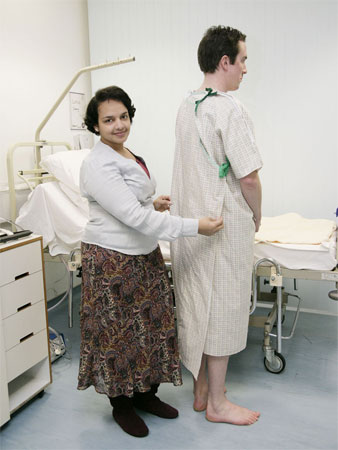New Hospital Gown Fights Deadly Bacteria

A new hospital gown could give patients a stylish cover-up plus a shield against lethal bacteria known to lurk in hospitals where people are already sick and weak.
The patient gown has a wrap-around design--complete backside coverage--with an anti-microbial coating that controls the growth of bacteria, including multiple-drug resistant Staphylococcus aureus (MRSA), or staph.
Now researchers conducting a clinical trial at University College London Hospital will test the gown's bug-busting ability on about 30 patients.
"I'm thrilled that my design is being used for the trial. I designed the gown to promote patient dignity, comfort and safety, but I'm delighted that it might help prevent the spread of diseases like MRSA," said the gown's designer Fatima Ba-Alawi.
With the rise in antibiotic use, there has also been an increase in infections that have developed ways to outwit such anti-microbials. From 1999 to 2000, nearly 126,000 people in the United States were hospitalized with drug-resistant infections diagnosed as MRSA. The organism Staphylococcus aureus can dwell on a person's skin without causing major problems there, allowing it to go unnoticed. If the superbug gets into your body, under the skin or into your lungs, it can cause lethal infections such as drug-resistant pneumonia.
Ba-Alawi created the gown design while a student at the University of Portsmouth in the United Kingdom. With maximum cover-up plus carefully placed closures, the gown [image] facilitates access to the patient's body for examination and makes gown-changing simple. The result is less patient handling, which reduces the chances of infection spread between patient and hospital worker.
The design caught the attention of Carrington Career & Workwear Ltd whose product, Permagard, provides the bug-busting ingredient.
Get the world’s most fascinating discoveries delivered straight to your inbox.
Unlike many anti-microbial coatings that kill bacteria with chemical poisons, Permagard uses physical stealth. On contact with a bacterium, Permagard rips through the invader's cell wall and annihilates it. The physical attack means bacteria are unable to develop a resistance like they could against a substance.
In the clinical trial, gown-wearing patients will remain in an intensive care unit for eight weeks. Scientists will run medical tests on patients and staff after the trial to count the number of bugs on the gown.
- VIDEO: Making Killer Flu
- Top 10 Mysterious Diseases
- War on Bacteria is Wrongheaded
- Inside Look: How Viruses Invade Us
Jeanna Bryner is managing editor of Scientific American. Previously she was editor in chief of Live Science and, prior to that, an editor at Scholastic's Science World magazine. Bryner has an English degree from Salisbury University, a master's degree in biogeochemistry and environmental sciences from the University of Maryland and a graduate science journalism degree from New York University. She has worked as a biologist in Florida, where she monitored wetlands and did field surveys for endangered species, including the gorgeous Florida Scrub Jay. She also received an ocean sciences journalism fellowship from the Woods Hole Oceanographic Institution. She is a firm believer that science is for everyone and that just about everything can be viewed through the lens of science.
